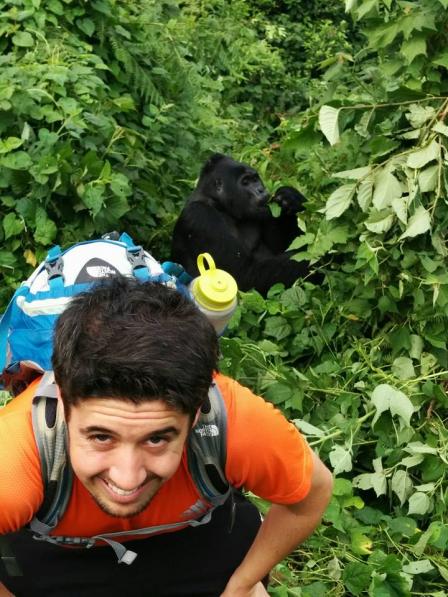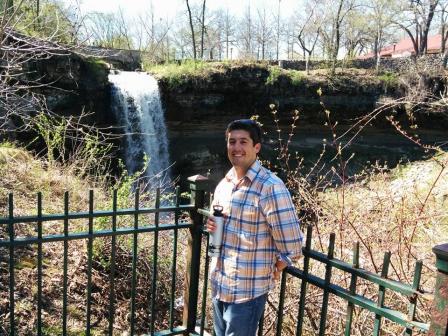Meet EPA Scientist Jason Berner
Jason Berner likes that his science makes a difference on a local level by helping communities use green infrastructure to reduce stormwater runoff.
Tell us about your background. Meet EPA Scientist Jason Berner!
Meet EPA Scientist Jason Berner!
I have a BS in natural resources and environmental science, and a MLA (masters of landscape architecture) with a focus on ecological design from the University of Illinois at Urbana-Champaign. I started at EPA in 2007 working on wetlands protection in Region 2. I worked on watershed management in the New York City drinking watershed, based in the Catskills Mountains. From there, I started doing work on urban stormwater management and planning tools that communities and water utilities could use- such as the National Stormwater Calculator.
When did you first know you wanted to be a scientist?
I first knew sometime during the middle of undergraduate studies. I took a course on environmental science that was focused on how the University of Illinois campus could be more environmentally sustainable and how ecological restoration could be done on campus. It really helped me get a better understanding of how scientists could make an impact locally.
How does your science matter?
Green infrastructure looks at how urban environments can be designed and planned to mitigate and adapt to some of the impacts of climate change, such as increased flooding. My research helps communities implement green infrastructure practices and looks at how the application of that type of technology can reduce stormwater runoff. Green infrastructure can be used at the local level, but it can also have a regional impact by helping cities plan out their urban infrastructure.
What do you like most about your research?
I like that I get to interact with different cities and provide technical assistance on how they can use our tools. It’s a good mix of interacting with city staff and local residents. I get to train their staff engineers and also talk with local citizens and land owners who are interested in learning about green infrastructure.
If you could have dinner with any scientist, past or present, who would it be? What would you ask him or her?
I would have dinner with Stephen Hawking. I would ask him which planets may have life forms that exist in the universe; and how they may be similar to human beings and Earth’s ecosystems. And what would life be like living on Mars? I don’t think he would have an answer, but it would be entertaining.
If you weren’t a scientist, what would you be doing?
I was in the Peace Corps in Mexico, so I would take time to travel to different countries and learn new languages. I would explore natural areas—like Patagonia, New Zealand, Costa Rica, Thailand, and the Galapagos—and try to understand how resources provide ecosystem services to the people that live or rely on these areas.
If you could have one superpower, what would it be and why?
Power of flight because it would be great to have the perspective that birds have and to not have any obstructions from things on the ground.
Any advice for students considering a career in science?
Take the time to explore different fields of environmental science and see what opportunities are available in the public, nonprofit, and private sectors. Being a good scientist relies on both your technical skills as well as your people skills. You need to spend some time doing scientific field work to understand the true impact of your work. And then you need to be able to take the field work and bring it back to more of an office-based culture.
What do you think the coolest scientific discovery was and why?
I was in a training and we watched a clip on Apollo 13. It made me realize that even though it’s been a long time since humans landed on the moon, it was probably one of the greatest scientific accomplishments. It didn’t just show us how they landed on the moon, but how it inspired the entire world to push towards new scientific discoveries. People were glued to their television during this, and it’s a great example of how when there is a great desire, people will push scientific limits and possibilities.
What do you think is our biggest scientific challenge in the next 20/50/100 years?
Our biggest challenge will be figuring out how to preserve our natural habitats and the species that live in them under climate change and urbanization. We need to ensure that critical ecosystem services are protected, such as supplying clean air and drinking water. It’s important that we find creative ways to protect our natural habitats in the midst of urbanization.
 Whose work in your scientific field are you most impressed by?
Whose work in your scientific field are you most impressed by?
Two individuals—the first is Ian McHarg, who was a landscape architect and one of the pioneers of using green infrastructure in urban areas; best known for his book entitled Design with Nature. A more traditional scientist is Aldo Leopold, who was a restoration ecologist from Madison, Wisconsin. I learned a lot of the principals of ecological restoration and design from their work and philosophies.
You’re stranded on a desert island with a community of other survivors – what is your job?
I would help build the tents and dive for fish. And I would lead camp fire songs and stories—I’ve been known to play a hand drum. If it’s a nice island there’s no reason to leave quickly, right?
